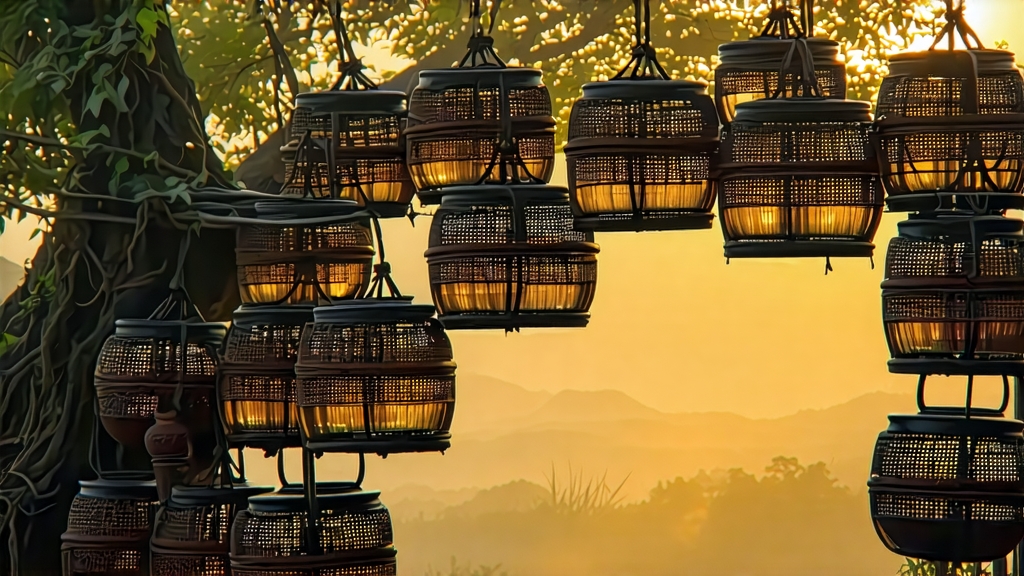
Tucked away in the humid, karst-pocked mountains of southern China’s Guangxi Zhuang Autonomous Region, Liu Bao tea has spent four centuries quietly transforming from a bitter frontier commodity into one of the most sought-after dark teas on the planet. To the uninitiated it looks like humble, jet-black leaves pressed into a bamboo basket; to the connoisseur it is liquid history—an edible archive of trade routes, ethnic craft and microbial artistry.
-
From Military Rations to Collector’s Trophy
The name “Liu Bao” literally means “six forts,” a reference to the six defensive stockades that once guarded the small town of Cangwu County in Wuzhou. During the Ming-Qing transition (mid-1600s), the Qing army requisitioned large quantities of sun-dried tea from local Yao and Han growers to provision border garrisons. The tea had to survive a 2,000-kilometer trek along the Xun River and then the Pearl River system to Guangzhou, followed by a sea journey to the Strait of Malacca. Producers discovered that the hotter and more humid the hold of the junk, the mellower the tea became. By the time the chests reached Singapore, the once-astringent leaves had mellowed into a deep, sweet liquor that cooled the body and settled the stomach in tropical heat. Malayan tin miners and rubber tappers paid for it with hard currency; Chinese medicine shops sold it as “shan cha” (mountain tea) to dispel dampness. In 1801 the Jiaqing Emperor listed Liu Bao as one of the “Eight Famous Teas” presented at the Autumn Tribute, cementing its prestige. -
One Leaf, Many Faces
Modern Liu Bao is classified by four intertwined variables: cultivar, picking standard, piling method and aging vessel. The indigenous Da Ye Zhong (large-leaf) variety, a close cousin of Yunnan’s Assamica, dominates. Within Da Ye Zhong, micro-terroirs matter: leaves from the high-altitude Liubao village itself yield a lighter, orchid note, whereas leaves from the lower, warmer Tengxian county give a darker, taro-like sweetness. Picking standards range from single-bud (for limited-edition “gong ting” cakes) to four-leaf-and-a-bud (for everyday “san jian” loose tea). After primary processing the tea is either traditionally wet-piled (“wo dui”) for 30–45 days or lightly fermented for only 15 days, producing respectively “shu” (ripe) and “sheng” (raw) Liu Bao. Finally, the tea may be aged in woven bamboo baskets, clay jars, teak chests or even buried in cool river sand for decades, each micro-environment imprinting its own microbial signature. -
The Craft: Where Tea Meets Microbiome
Liu Bao’s magic lies in a controlled re-fermentation that predates shu Pu-erh by at least two centuries. Fresh leaves are withered under the subtropical sun until they lose 65 % moisture, then wok-fired at 200 °C for eight minutes to arrest oxidation. While still warm they are rolled for 40 minutes on bamboo trays to rupture cell walls, after which they are sun-dried again to 10 % moisture. The crucial step is “wo dui”: the dry maocha is sprayed with misty mountain water (pH 6.8, rich in manganese and zinc), heaped 70 cm high and covered with jute sacks. Internal temperature climbs to 55 °C within 36 hours; thermophilic bacteria such as Bacillus subtilis and Aspergillus niger bloom, breaking down bitter catechins into theaflavins and gallic acid. Every 48 hours the pile is turned by barefoot artisans who judge readiness by aroma: a shift from grassy to dried longan signals the first turn; a deep betel-nut scent means the pile can be dismantled. After 30–45 days the tea is sun-dried again, then steamed and pressed into 50 kg bamboo “lang” baskets lined with wild taro leaves. The taro leaves impart a subtle saponin sweetness and prevent mold. -
Brewing the Basket: Ritual and Ratio
Liu Bao forgives the novice but rewards the meticulous. Start by breaking off 8 g from the basket—enough to fill a 150 ml Yixing teapot or a 120 ml gaiwan. Rinse once with